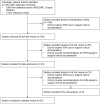Clinicians' reasoning as reflected in electronic clinical note-entry and reading/retrieval: a systematic review and qualitative synthesis
- PMID: 30576561
- PMCID: PMC7647174
- DOI: 10.1093/jamia/ocy155
Clinicians' reasoning as reflected in electronic clinical note-entry and reading/retrieval: a systematic review and qualitative synthesis
Abstract
Objective: To describe the literature exploring the use of electronic health record (EHR) systems to support creation and use of clinical documentation to guide future research.
Materials and methods: We searched databases including MEDLINE, Scopus, and CINAHL from inception to April 20, 2018, for studies applying qualitative or mixed-methods examining EHR use to support creation and use of clinical documentation. A qualitative synthesis of included studies was undertaken.
Results: Twenty-three studies met the inclusion criteria and were reviewed in detail. We briefly reviewed 9 studies that did not meet the inclusion criteria but provided recommendations for EHR design. We identified 4 key themes: purposes of electronic clinical notes, clinicians' reasoning for note-entry and reading/retrieval, clinicians' strategies for note-entry, and clinicians' strategies for note-retrieval/reading. Five studies investigated note purposes and found that although patient care is the primary note purpose, non-clinical purposes have become more common. Clinicians' reasoning studies (n = 3) explored clinicians' judgement about what to document and represented clinicians' thought process in cognitive pathways. Note-entry studies (n = 6) revealed that what clinicians document is affected by EHR interfaces. Lastly, note-retrieval studies (n = 12) found that "assessment and plan" is the most read note section and what clinicians read is affected by external stimuli, care/information goals, and what they know about the patient.
Conclusion: Despite the widespread adoption of EHRs, their use to support note-entry and reading/retrieval is still understudied. Further research is needed to investigate approaches to capture and represent clinicians' reasoning and improve note-entry and retrieval/reading.
References
-
- Strauss AL, Fagerhaugh SY,, Suczek B, Carolyn LW.. Social Organization of Medical Work. Chicago, IL and London: University of Chicago Press; 1985.
-
- Bansler JP, Havn EC, Schmidt K, Mønsted T, Petersen HH, Svendsen JH.. Cooperative epistemic work in medical practice: an analysis of physicians’ clinical notes. Comput Support Coop Work 2016; 256: 503–46.
-
- The Office of the National Coordinator for Health Information Technology – Health IT Dashboard. https://dashboard.healthit.gov/quickstats/quickstats.php. Accessed July 27, 2018.
Publication types
MeSH terms
LinkOut - more resources
Full Text Sources
Miscellaneous


